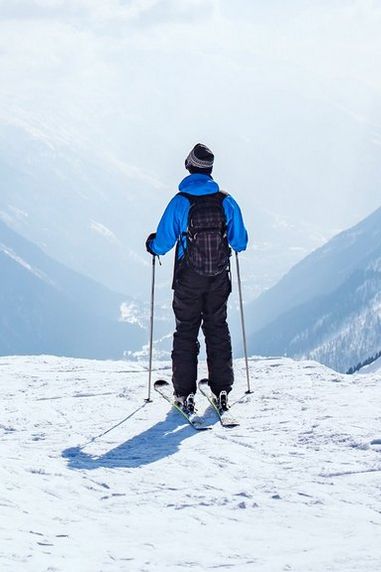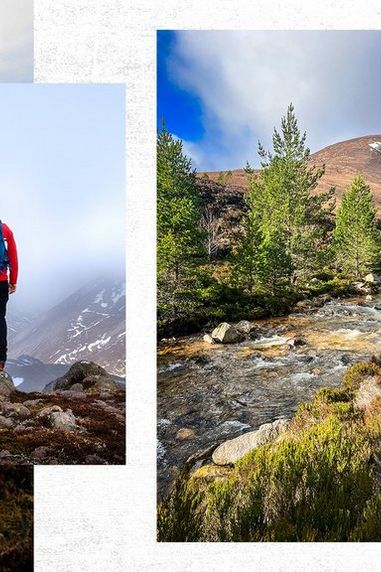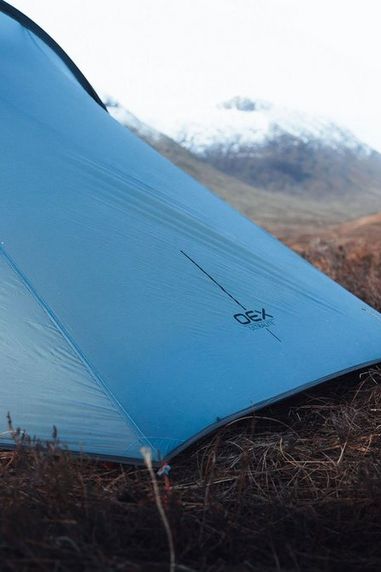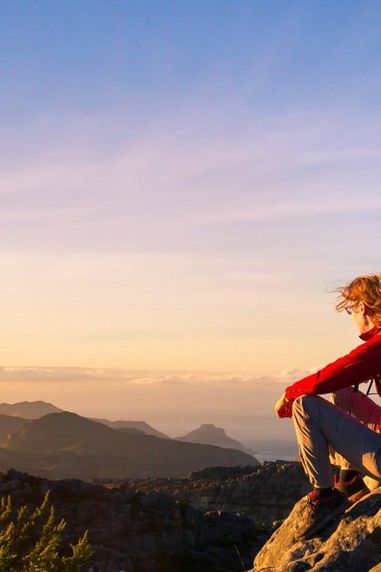With the changing scenery, frosty mornings and fewer people to share the hill with, wild camping during the colder months can be a greatly rewarding experience. A successful camp at any time of year comes down to planning, but when the weather turns colder and the nights longer, being prepared for off-season camping is essential.
Whether you're new to winter wild camping or just want to cross-reference your kit list, we've put together a comprehensive guide to help you stay safe and enjoy a camp under the night sky.

Preparing for an off-season camping trip
Pick your camping spot wisely
Picking the right spot to pitch is the first step to a successful camp. Here are some things to think about when choosing your location:
Avoid places that might become water-logged during rainy downpours. Steer clear of places where your tent will be fully exposed to strong winds, i.e. hilltops, centres of large open fields and places where gusts can be channelled by rocks. Use natural wind shelters such as boulders and trees. Aim for a place with access to clean, running water such as a stream. If you're not sure about the safety of the water, boil it before drinking or treat it with a water filtration aid.
If you have chosen to wild camp, it's a good idea to choose an area you’re familiar with or do a recce beforehand. It's best to camp in an area where you have the landowner's permission. However, there is a generally assumed tolerance for wild camping in the most remote parts of the country as long as you are respectful to the land and move on swiftly if asked to. If you're new to wild camping, read more about the basics in our Wild Camping Guide for Beginners, including the importance of leaving no trace.
Always take a map and compass, and familiarise yourself with the area before setting off
Check the weather forecast before you set off
The mountain forecast is often the most reliable for remote areas, especially if you are pitching at altitude. Knowing the weather conditions you’ll be dealing with during your camp will help you prepare accordingly, or help you avoid a dangerous camp if weather warnings are in place. Checking the wider area is heavily advised and checking live weather maps regularly will help you avoid any unwanted meteorological surprises.
Know what time sunset and sunrise are
In autumn and winter, the sun sets early and quickly, so reaching your spot while it is still light is important to avoid having to set up camp in the dark. Be familiar with the equipment you’ll be using, make a checklist and give yourself ample time to reach your chosen spot.

Staying dry on autumn and winter camps
Pick a tent with a good hydrostatic head
Your tent is the number one most important piece of equipment you’ll be taking with you. Most tents have a waterproof groundsheet built-in, but you can double-up protection with a groundsheet that prevents water from seeping in and adds an extra layer of insulation from the cold ground.
It’s not just rain to keep at bay, high winds and unexpected snow can pile the pressure on the integrity of your tent. So, a strong tent made for the trials of off-season camping is a bit of a no-brainer. Backpacking tents are the best for lightweight camping in the wild. A semi-geodesic backpacking tent is the pick of the bunch. These tents are spherical or partially spherical structures made up of interconnected triangles, creating a self-supporting and more importantly strong structure. If you prefer to wild camp in a bivvy, then a reliable tarp is essential for out-of-season camping.
Need more help? Read our guide to choosing the right tent.
Stay dry on your way to the camp spot
A good quality waterproof jacket with a Hydrostatic Head of 10k or above will help you stay dry if you encounter persistent rain. It's also important to have reliable waterproof walking boots and a pair of waterproof overtrousers to stuff in your pack for wet conditions. Opt for a rucksack with an integrated rain cover. If yours doesn’t have one, pack your kit inside some dry bags within your rucksack.
A waterproof map case is an affordable piece of kit that instantly makes life easier on a winter hike or camp. Not only will it keep your map dry, but it can also be used to safely store other accessories. The clear material is touchscreen compatible so you can use your phone or GPS in the rain with no risk of damage.

How to stay warm on cold camps
Use four-season sleeping equipment
Every sleeping bag has a 'comfort' thermal rating. There may be other temperatures such as 'limit' and 'extreme' but these are to be ignored if you want to enjoy your wild camp. They are categorised into seasons to make it easier to use the right sleeping bag at the right time. For camping in cold weather, you’ll need a four-season sleeping bag. These are sometimes referred to as 'all-season sleeping bags'.
Down bags are usually best at this time of year due to their ability to trap a layer of air between feather clusters, forming a barrier that helps retain body heat. This layer of air acts as a buffer against the cold, keeping you warm and cosy even in cold weather conditions. However, if your bag becomes damp, the down's ability to trap air will fail, as will its ability to keep you warm. Synthetic bags perform better in damp conditions. There are also down bags that have hydrophobic treatment to protect the fibres when wet. If you have a down bag that doesn't have this treatment, you can do it yourself with wash-in treatments like Grangers Down Repel or Nikwax's Down Proof.
A sleeping bag liner is a game changer in winter. It weighs very little, packs down small and adds a soft, instant warmth to your bag that will dial up the comfort levels. It's also easy to wash and will keep your sleeping bag clean. For best performance, opt for a silk liner.
Use a sleeping mat with a high R-rating
Sleeping Mats provide comfort on hard ground and insulate you from the cold. They're an essential piece of off-season kit, though not all are as effective in low temperatures. Self-inflating mats (SIMs) are easy to inflate and pack down small in your pack. Foam mats are bulkier, but you can get around this issue by attaching them to the outside of your pack.
The spec to look for from a sleeping mat is its R-value, which is a reliable measure of a mat's thermal performance. R-ratings are often grouped in seasons like sleeping bags to make it easy to pick the right one for the time of year that you're camping. Check out our sleeping system guide for a more in-depth guide on R-ratings and how to create the perfect sleeping kit combo for low temperatures.
Tent-only dry clothing
Consider this a pro tip for cold weather camping – always bring a change of clothing for inside the tent and pack it in a sealed dry bag during the hike. If your hiking kit gets wet or muddy, you won't be left feeling cold and miserable in your tent. Plus, you can switch into layers that are better suited to keeping you warm when you aren't moving around, like wool.
Merino wool baselayers are impressively insulating while having sweat-wicking and naturally odour-resistant properties. We'd recommend a pair of baselayer trousers, a long-sleeved top and spare pair of socks. A woolly hat and a neck chute are also recommended. Keeping your head and neck warm is important as they're more exposed to the cold air when you're in a sleeping bag. To stay warm in the evening, pack an insulated jacket and a pair of gloves. Both can be stuffed inside the dry bag when you sleep and used as a makeshift pillow.
Save space by packing your insulated jacket inside a dry bag and using it as a pillow
Pick the right sized tent
In the colder months, a small tent is better. A larger tent will allow more air between you and the outer wall of your tent, lowering the internal temperature. Another tip to keep the cold out is to avoid condensation building up on the inner walls of your tent. It might seem odd to air out your tent in cold weather, but if you're staying for multiple nights and the weather outside is dry, it’s beneficial to open all doors and vents and rid the inside of any moisture that might have accumulated during the night.

Wild camping cooking for winter nights
Camping food
Warm kit will only go so far if you haven’t got the energy to heat yourself. A high-calorie intake is an absolute must when you’re spending extended periods of time in low temperatures, especially when you’ve hiked to your chosen camping spot. Camping foods like energy gels, protein bars and high-calorie drinks are useful, but a hot meal washed down with plenty of hot drinks will give your body what it needs to stay warm all night.
Camping meal pouches are designed for ultimate convenience on a campout. Submerge them in boiling water for a few minutes and enjoy a tasty, high-energy meal. Once done, you can dispose of the empty pouch by sealing it in a spare dry bag (this is your temporary bin until you get back to civilisation) and you're left with no washing up. You can also recycle the hot water you boiled the pouch in to make a hot drink.
Choosing the right cookset
A good gas stove, a pot, a canister of gas and a firelighter is all you'll need to quickly heat up camping food pouches. Lots of wild campers opt for all-in-one cooking systems such as the OEX Heiro Solo Stove and the Jetboil Flash. They are big enough to heat meal pouches and make hot drinks without having to carry a separate pot or pan, and often come with a built-in ignitor. We'd always recommend bringing a backup flint or lighter just in case.
It’s important to note that in colder temperatures butane gas doesn’t perform as well, so try to store it in your pack or somewhere where it might be more shielded from the cold air or use gas designed for low temperatures like Coleman Xtreme.
Boiling water from streams or fresh snow can be used for cooking to save weight in your pack
Going to the toilet on a wild camp
If you're wondering how to poo when wild camping, you're not alone. It's one of the most frequently asked questions! Find a spot away from camp and at least 50 metres away from any streams or rivers. Use a camping trowel to dig a hole. Once you're done, use biodegradable toilet paper or wipes then cover the hole with the soil you dug out.

The best lighting for wild camping
You’ll need a reliable light source to ensure you can move around safely and find any kit you need in the dark. The best choice for this is a head torch. It's a hands-free option so you can perform tasks like cooking easily or just keep your hands warm without having to carry a handheld torch. A good tip when you're settling down in your tent is to use the head strap to dangle the torch from the roof of your tent and use it as a lantern. Using the dim setting or red light mode on your torch will give you enough light to read a book or plot tomorrow's route on your map before you sleep.
Look for a head torch that comes with an SOS light mode. This is a great extra precaution in case of emergency and you need to signal for help. Bringing multiple lighting options is advised along with a fully-charged power pack to recharge dead devices. Another dry bag can be used to keep all of your electrical items safely stored and away from the elements.

Staying safe when camping in winter
Following the advice we have given to stay dry, warm and fed will help you stay safe in almost all out-of-season camps, but it's important to prepare for any eventuality when heading into the wild. An ounce of prevention is worth a pound of cure, as the saying goes.
Always tell someone where you are going and when you expect to return. That way if you don't return in time they can raise an alert. Be as detailed as possible, including your planned route to the camping spot. GPS or What3Words coordinates are specific points that would help rescuers find you quickly should they need to. Make sure your mobile phone is charged so you can make contact with civilisation if you need to. When camping in remote spots, signal can often be limited. A handheld GPS with messaging and location capabilities is a brilliant piece of safety kit, as it uses a different type of global satellite coverage that will keep you connected no matter where you explore.
A first aid kit and some form of emergency shelter are two pieces of kit that should be in your pack for every mountain hike or wild camp, especially in the winter months. A basic survival bag is a waterproof and windproof emergency shelter that helps preserve body heat and is highly visible to searchers should you become injured or caught in dangerous weather conditions. Other alternatives are emergency thermal bivi bags or emergency shelters.
What to pack for off-season wild camping

Sleeping & Shelter
Food & Hydration
• Tea/Coffee




